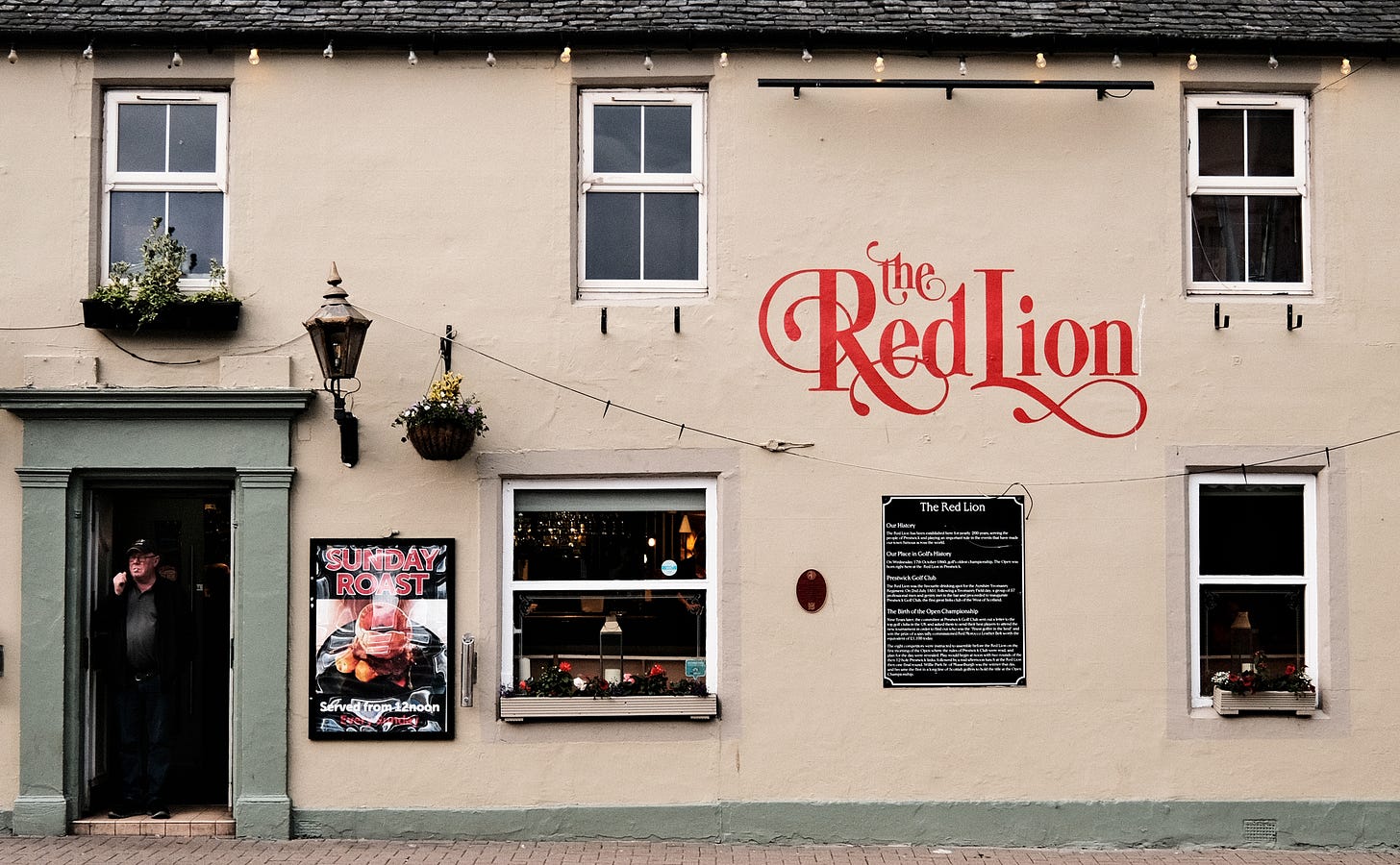The second round of the 152nd Open Championship at Royal Troon was full of dirty scorecards and disparate nines. Joaquin Neimann had an 8 on the eighth and shot 40-31. Justin Thomas went around the old links in 45-33. Aguri Iwasaki carded 9s on the Nos. 13 and 14 on his way to an inward 52 after going out in 39. Ten of the top 20 players in the world failed to make the cut, among them Rory McIlroy, whose attempted bounce back from deep U.S. Open disappointment had all the spring of a broken Slinky. He went 78-75, with nines of 42 and 33 on Friday. His conqueror at Pinehurst No. 2, Bryson DeChambeau, didn’t fare much better, shooting nine over for 36 holes to join McIlroy on the weekend sidelines. Tom Watson’s distinction of winning The Open at Troon in 1982 following his U.S. Open victory a month earlier is safe.
Amid the messes on a windy, challenging Friday, which was particularly nasty for the afternoon starters, the surprise name on the leaderboard played commendably. Englishman Daniel Brown followed up a 65 with a 72 and is tied with countryman Justin Rose at five under, two strokes behind Shane Lowry. Brown’s outstanding play halfway through his first major championship brought an experience foreign to golfers ranked 272nd in the world: having to wait nearly 24 hours to tee off in the third round, until 3:45 British Summer Time, a final-group pairing with Lowry—lots of time for butterflies to gather.
Brown is 29 years old, with a victory on the DP World Tour last year after a decade of striving up the pro golf ladder. This season has been unremarkable until this week, a string of missed cuts leading up to a 61st-place in last week’s Scottish Open. Brown isn’t the first Briton to unexpectedly lead or lurk after 36 holes an Open. Scot David Huish led halfway in 1975 at Carnoustie. Brown will try to avoid doing what Huish did, which was shoot 76-80 and tumble down into a tie for 32nd.
It has been noted this week that Brown has the same name as the thriller author of the 2003 bestseller The Da Vinci Code, which was turned into a hit movie. Brown the golfer said he hadn’t read the book or seen the film. “I’m not a big book reader,” he told reporters Friday, when he also acknowledged that he prefers “Dan,” saying “Daniel is usually when I’m getting told off my mom and dad.”
Nonetheless, that a “Daniel Brown” is among the leading characters in the story unfolding at Troon provides an appropriate tie to some very early golf history on the Ayrshire coast.
The Open is being played just four miles north from the site of the first Open, on Oct. 17, 1860, at Prestwick. Eight golfers gathered at the Red Lion Inn, played two loops of 12 holes, went back to the Red Lion for lunch, and returned for the final dozen holes.
The Red Lion in Prestwick, where golfers gathered before and during the 1860 Open.
(Photo by Bill Fields)
Seven of the players were Scots, including the winner, Willie Park Sr. of Musselburgh, whose 174 total beat Prestwick’s Keeper of the Green, Tom Morris Sr., by two strokes to claim the red leather belt with ornamental silver buckle that preceded the claret jug as The Open’s prize. One golfer was from England. His name was George Daniel Brown, the first Englishman to play in The Open and the first English professional golfer—the person who started the path that would be followed by J.H. Taylor, Joyce Wethered, Henry Cotton, Tony Jacklin, Nick Faldo, Laura Davies and so many others, all the way to Brown and Rose who are battling this weekend in Scotland.
Golf historians David Malcolm and Peter Crabtree detailed George Daniel Brown’s contributions to the game in a fascinating 2007 article in The Scots Magazine. Brown was born in 1836 in London “into a family of coopers,” craftsmen who produced wooden barrels and baskets. The authors note that “George was born and reared on the edge of Richmond Park, Putney Heath and Wimbledon Commons; the closest open spaces to central London; places well documented where ex-patriot Scots enjoyed what they could make of the game in public parkland. Perhaps George made himself available to carry clubs for the Scots gentlemen, became smitten by the game and resolved to make his life in it.”
Brown took his love of golf north, in 1860, playing in the inaugural Open and making his way to St. Andrews. According to Malcolm and Crabtree, Brown eloped with the daughter of a prominent resident and became a golf professional and clubmaker operating out of 6 Pilmour Links before Old Tom Morris bought the property in 1866. “…George did not make a favourable impression on St. Andrews’ insular townspeople. George was an outsider in every sense. Wearing a bowler hat at a rakish angle with a suit and waistcoat he was altogether different from the men of the links.”
Brown played in two Opens after the first one, finishing ninth in 1861 and fifth in 1863.
Brown and his wife, Clara, left St. Andrews in 1866 after Morris’ purchase of the property where he had his shop, and returned to Kent, England, the pioneering pro’s golf a memory that he left behind in Scotland. He and his wife died in London in 1902. “There is no record of George golfing in Kent or anywhere else after his departure from St. Andrews,” Malcolm and Crabtree wrote. “George Daniel Brown came and went from golf in six years, but he left an indelible impression on the game.”
The 21st century’s Daniel Brown will try to do the same, just a handful of miles from where George Daniel Brown was part of something new, something others might read about a long time from now.



